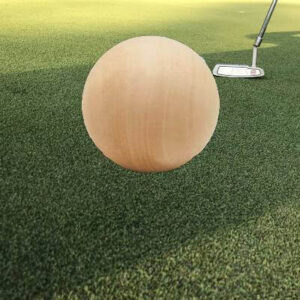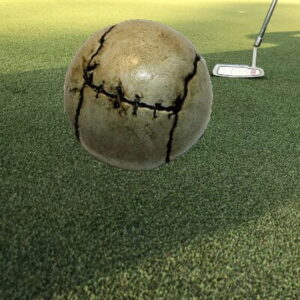Floating Chipping Greens – Top Pool or Lake Floating Golf Greens
Are you looking for an innovative way to practice your golf game this summer? Why not try a floating chipping green? Floating chipping greens are

The golf ball is one of the most critical pieces of equipment in the game of golf, and the technology of the golf ball has evolved greatly over the years. Being made of multiple materials, it has gone from being a hard, solid sphere to being softer and more aerodynamic. From the very beginning of history to now, we have seen a dramatic evolution and transformation in golf ball technology and materials. The best part about these advancements is that they come at an affordable cost for those who want to play the game and perform better.

From the golf history books, there is no certainty that the first sanctioned golf leagues were ever played with wooden golf balls, however, that does not mean they weren’t used for recreational play.
With every other sport starting in the 14th century utilizing some form of wooden golf sticks/balls, golf is no different. The most popular golf balls at this time were made from beech wood. The great thing about the wooden golf ball is that it floated in water (for a little bit), and could be refinished pretty easy.
While the wooden golf ball got the sport off the ground, there were many drawbacks. For instance, the perfectly round shape was difficult and time-consuming to make. Each ball flew drastically different and would fly no more than 100 yards (no matter what object you hit it with). Also, the wooden golf ball was susceptible to all the weathering conditions, chips, and breakage. This is why it did not last very long or have any record of being used professionally.
The evolution of the golf ball was some sort of a fluke. From the record books, the hairy golf ball was the first professional golf ball adopted by Scotland in the 1500s. These different types of golf balls were sown leather filled with cows’ hair or straw and made and imported from the Netherlands. They were able to travel further than wooden golf balls, with their max range being around 125 yards.
Scotland eventually picked up the manufacturing making the hairy golf ball the first “common” and affordable golf ball. Even after the introduction of the feathery golf ball, the affordability of the hairy golf ball is much greater. However, hairy golf balls were very easily damaged when they got wet or during any inactive golf season, prompting the advancement of golf ball technology.

The feathery golf ball is the most famous old-school golf ball. Most people who do not know the history think this was the very first iteration of the golf ball. This ball was used in golf for a long time despite the time and cost of making a single golf ball.
The first version of a golf ball was made from goose feathers and wrapped tightly in leather and sewn together as densely as possible. It would take golf ball manufacturers a long time to replicate the conditions of this ball, making ONLY 2 to 3 in a day’s work. This densely packed leather ball was surprisingly firm and was finished with several coats of paint for appearance. As one can imagine, the ball was fragile and regularly needed repair if you did not lose it.
The feathery golf balls were almost double the price of the hairy golf balls but manufacturers finally found a way to substitute materials and started making lesser quality balls called a crown which eventually became known as the common feathery golf ball. Depending on the different types of golf course grass, these balls were a better product.

The gutta-percha golf ball was the first to gain widespread acceptance and remained in use for about thirty years. This specific ball was first used in Scotland in the 1800s and was made from a material called gutta-percha.
Gutta-percha is a natural latex produced from the sap of trees native to Malaysia, Indonesia, and Sri Lanka. The balls were originally made of straight pieces of gutta-percha drilled out and then lacquered to form a smooth, solid ball. However, after playing a round, the smooth gutta golf ball would need to be boiled to fix any flat spots caused by the golf club’s impact, but much easier to repair than its predecessors. Due to the density, now golfers would need to know how to repair a divot these balls left in the greens.
The technology and evolution of the golf ball made from gutta-percha at this time were so much higher than all other materials, many other sports like cricket picked up this idea and started using the gutta-percha material on all high-impact sports balls. The advancement of the gutta-percha ball excelled the game of golf drastically.
Golf balls have dimples because now because of the evolution of the golf ball from playing with the old gutta-percha golf balls. Many people noticed that the golf ball flew better and further if it was dinged or beat up. This caused golfers to purposely add dimples to their balls, arguably figuring out the science of aerodynamics way before the wright brothers took their first flight.
This means that even before the wright brothers were able to discover the ins and outs of aerodynamics, golfers realized that dimples helped the air flow fly around the golf ball smoother, causing a straighter ball path. This accidental advancement in golf ball technology revamped the game and made the days of the perfectly round golf ball obsolete.
The Bramble Golf Ball was the next game-changing innovation in the golf ball industry. Its innovative design was engineered to take the golfer’s game to the next level. The Bramble golf ball introduced symmetry to the golfing world. Now gutta golf balls were designed with a pattern that, through science, improved the golf ball’s flight, allowing golfers to hit the ball farther and straighter than they ever had before.
The bramble name comes from the bramble berry, which resembled the new design of the golf ball. With this era, many different golf ball patterns began to emerge. Mesh, reverse, and square mesh are just a few popular patterns designed to help the ball’s flight pattern.
The evolution of the golf ball really took a turn with the development of the rubber-centered golf ball. The first rubber golf ball was created around 1850 and was made from a solid piece of rubber. These balls were prone to breaking apart easily, which led to the introduction of the wound golf ball in 1899, which consisted of a piece of yarn wound tightly around a solid rubber center. It was an essential invention, allowing golfers to hit further ball distances. This was the first move towards the golf ball we all know today and quickly replaced the gutta ball as the new standard worldwide.
Coburn Haskell was deemed the father of the modern-day golf ball with his invention and patent of the rubber golf ball, aka The Haskell Golf Ball. Rubber revolutionized the production of golf balls, making them more readily available, more cost-effective, and forgiving. As one could imagine, this did amazing things for the game of golf.
The invention of the two-piece golf ball in 1958 changed the game of golf as we know it. The ball was easy to manufacture, and because it was made of two pieces, it had a much longer life than any of its predecessors.
This design allowed for more distance, which led to over 130 million rounds of golf being played in the U.S. that year alone. The introduction of this innovation changed the course of golf forever. Today, golfers all over the world use two-piece or three-piece balls. The pursuit for a better golf ball continues with companies regularly working with dimple patterns and density of the materials to be more forgiving.

Categories
Are you looking for an innovative way to practice your golf game this summer? Why not try a floating chipping green? Floating chipping greens are
Instructional Video Coming Soon
How I got on hole 16 (The Stadium hole) at the Waste Management Phoenix Open with little to no wait!! I also have tips and tricks on what to do once you are inside the gate and inside the stadium hole. Check this out if you ever plan to make a trip out! If you ever have the chance, it is definitely worth the trip.